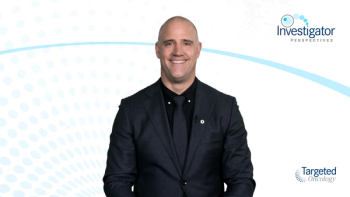
Selpercatinib: MOA and LIBRETTO Trial Data
Lori Wirth, MD, discusses the mechanism of action of selpercatinib and key data from the LIBRETTO-001 and LIBRETTO-531 clinical trials.
Episodes in this series

Lori Wirth, MD: Let’s talk briefly about selpercatinib. I’m going to show you the data in just a moment. In terms of the mechanism of action of selpercatinib, it was designed to potently and specifically inhibit the RET kinase. It blocks the activated RET kinase in the kinase domain, then it blocks the oncogenic signaling through the JAK-STAT pathway, the MAP kinase pathway, and other pathways that I mentioned. It was designed to inhibit the wild-type kinase that is present in the RET-fusion-driven cancers, as well as block all the known RET mutations that we see in medullary thyroid cancer. This includes RET V804, which we know is a gatekeeper resistance mutation that can arise in patients with RET-driven disease treated with the RET VEGFR multikinase inhibitors, vandetanib and cabozantinib. There is a small subset of patients with germline RET V804 mutations as well.
The LIBRETTO-001 trial was a phase 1/2 trial of selpercatinib and patients with RET-driven disease. There were cohorts of patients with non–small cell lung cancer with RET-fusion-positive disease, and then there were thyroid cancer cohorts. There were patients with MTC [medullary thyroid cancer] with RET mutations that had previously received vandetanib and/or cabozantinib, and then there was a cohort of patients with MTC with RET mutations who had not received either prior cabozantinib and vandetanib. There was recently an updated data set presented at ASCO [American Society of Clinical Oncology Annual Meeting] in 2021 that updated the numbers of patients and follow-up from the initial New England Journal of Medicine paper.
In that updated analysis set, there were 143 patients now treated with selpercatinib who had previously received either cabozantinib, vandetanib, or both. In the updated group of patients who were treatment naïve, there were 112 patients in that cohort of patients. In the patients with RET-fusion-positive advanced thyroid cancer, there were 22 patients who had received other systemic therapies and who were enrolled in LIBRETTO-001. And in the updated group of patients there were 12 RET-fusion-positive thyroid cancer patients who had not received prior systemic therapy beyond radioactive iodine. It’s important to note that in the patients with MTC who had been previously treated with cabozantinib and vandetanib, it was a heavily pretreated patient population; the same is true for the previously treated patients with RET-fusion-positive thyroid cancer. In these group of patients, the updated objective responses that were independently reviewed are shown here. We’re seeing an overall response rate of 69% in the patients with MTC who had received prior vandetanib and/or cabozantinib. In the patients who hadn’t been previously treated, the objective response rate is 73%.
These are data from the New England Journal of Medicine and not the updated patient population, so I’m going to start from the top on this slide. In the publication from the New England Journal of Medicine, the reported response rates are shown here. The objective response in patients who have been previously treated with cabozantinib and/or vandetanib by independent blinded review was 69%, and in the RET-mutant patients with MTC who hadn’t received either cabozantinib or vandetanib, the objective response rate was 73%. Then in the fusion-positive other thyroid cancer patients, we saw an objective response rate of 79%. I’ll point out a couple of things about those objective responses: we’re even seeing patients achieving a complete response, and the median duration of response is long; the median duration of response had not been reached for the patients with MTC, and the lower bound had been seen for the RET-fusion-positive patients with thyroid cancer of 18.4 months with a median not reached. The median progression-free survival for all 3 of these groups of patients had not been reached as well.
The waterfall plot looks great. This shows a waterfall plot for RET-mutant patients with medullary thyroid cancer who had not received prior vandetanib or cabozantinib, so you’re seeing disease shrinkage in almost every patient and a significant number of patients with 30% or more, including patients who have achieved a complete response. The durability of selpercatinib looks great, particularly in the cabozantinib- and vandetanib-naïve patient population shown; we’re seeing very promising duration of response and progression-free survival Kaplan–Meier curves where very few patients in this group are progressing.
We do think that, as Marcia mentioned, you see fewer adverse effects with RET-specific inhibitors compared with the VEGFR-RET multikinase inhibitors; that’s been my experience as well. But it’s not entirely a free ride, and there are some treatment-related adverse events. This table shows the most common grade 3 and 4 treatment-related adverse events. There are a lot of 0s, particularly in the grade 4 column. We see some hypertension, and there’s some transaminitis that can be seen in these patients as well. We can see some degree of diarrhea, fatigue, and constipation, and peripheral edema has been seen as well. Overall, only 30% of patients had to have dose reductions due to treatment-related adverse events, and only 2% of patients had dose discontinuation due to treatment-related adverse events. These were primarily increased ALT [alanine aminotransferase] or drug hypersensitivity in a couple of patients.
Based on these great data from LIBRETTO-001, we have a randomized international phase 3 trial called LIBRETTO-531 that examines selpercatinib compared with physician’s choice, cabozantinib or vandetanib in patients with RET-mutant positive, untreated, progressive medullary thyroid cancer. The enrollment criteria allows for enrollment of children as young as 12 years of age, and otherwise, they’re the typical enrollment criteria you’d expect. We aim to enroll 400 patients approximately to this randomized trial, and the trial is not blinded because we think you’ll be able to tell if the patient is on selpercatinib vs cabozantinib or vandetanib. Those patients who progress on cabozantinib or vandetanib will be allowed crossover to receive selpercatinib. Another thing that I want to highlight on this trial is that there’s a unique end point, which is treatment-failure-free survival. It’s a composite end point looking at both progression-free survival as well as treatment failure due to the toxicity of the agent.
This transcript has been edited for clarity.











































